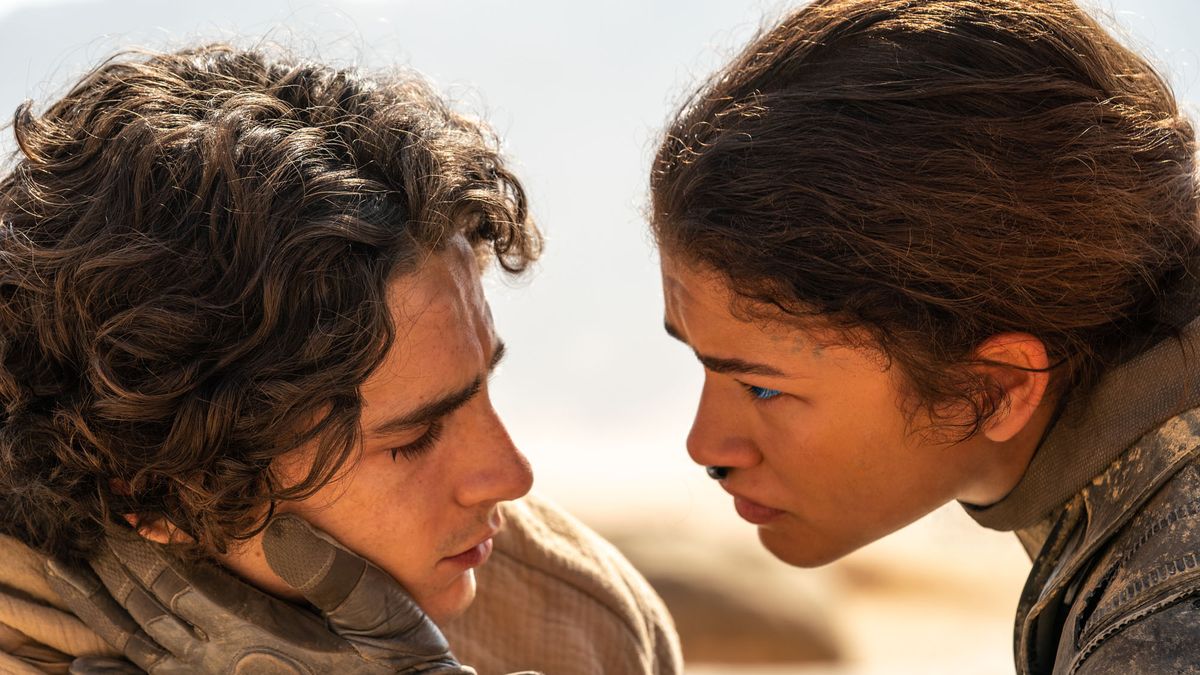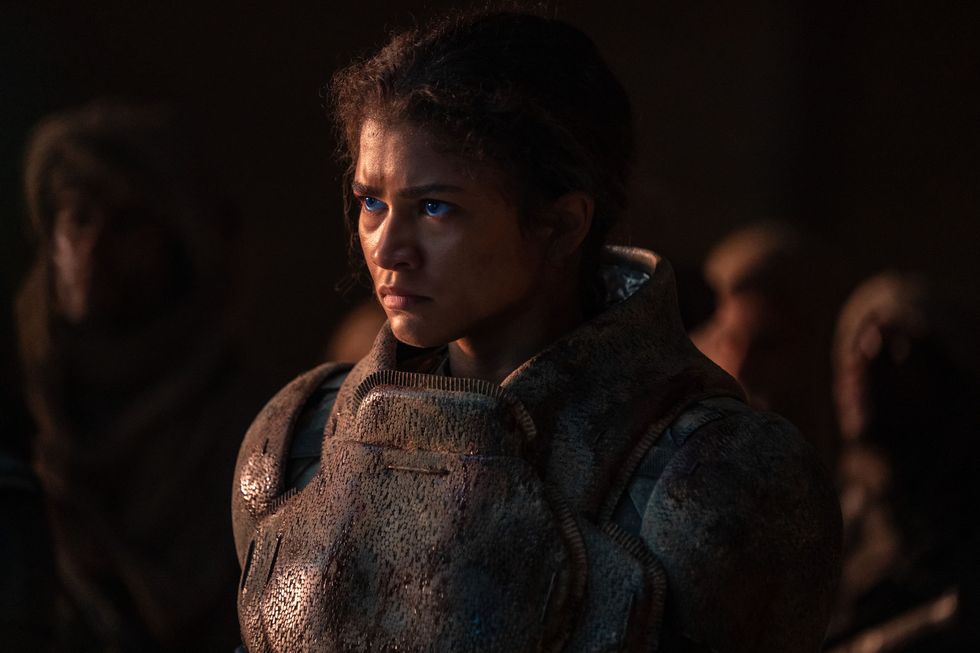This story contains spoilers for Dune: Part Two.
May thy knife chip and shatter! With these words, Timothée Chalamet has brought to life perhaps the most faithful cinematic version of Paul Muad'dib Usul Atriedes, Duke of Arrakis, who first appeared in the pages of Analog magazine in 1963 as part of a serialised novel called “Dune World.” Published in 1965 in one volume as Dune, Frank Herbert’s visionary book is synonymous with classic science fiction. It’s also considered one of the most politically savvy and complex novels of all time.
In 2021, Denis Villeneuve’s big-screen adaptation Dune: Part One stopped roughly halfway through the book, just after Paul defeats Jamis (Babs Olusanmokun). If you’re using the current Kindle edition of the book, this means that Dune: Part One stopped around page 495 out of 883. But because Dune’s appendices take up about 80 pages, that means Dune: Part Two is really only adapting about 300 pages of actual story, versus the nearly 500 pages Part One covered in 2021.
So, just how faithful is Part Two to these roughly 300 pages? The short answer is this: Dune: Part Two is somewhat faithful to the original novel, but decidedly less so than Part One. In the most general sense, Part Two replicates the tone, message, and basic events of the novel, certainly more so than the 1984 Dune. But the sand devil is in the details. And in these details, Dune: Part Two deviates from the novel in more than a few surprising ways. Leaving aside very minor changes, here are five massive differences between Dune: Part Two and the novel Dune.
The “North” and “South” Fremen split
From the very beginning of the movie, it’s made clear that some Fremen are less religious than others, and that a huge mass of “Southern Fundamentalists” will become fanatical followers of Paul once he embraces the mantle of the “Messiah.” The word “fundamentalist” does not ever appear in the text of Dune, and the idea that Paul will tap into religious fanatics in the South is something basically invented for the movie.
However, this is more of a logistical change than a thematic change. Both in the movie and in the book, Paul and Jessica are aware that the Bene Gesserit’s Missionaria Protectiva project planted religious prophecies on Arrakis centuries prior, mostly to help out-wolders and elites exactly like Paul and Jessica. What makes the film different is the way this plays out. The result — that Paul has an army of fanatics at his side — is the same in both the film and book. But, the idea that Chani views Stilgar as a “Southerner” obsessed with religion is not in the book at all.
Chani’s Path
Speaking of Zendaya’s excellent turn as Chani, this character is by far the most changed from her book counterpart. Throughout Dune: Part Two, Chani makes it clear that she views the prophecy of the “Lisan al Gaib” as a bad thing, and a way for the Fremen to be further enslaved. In the book, Chani stands by Paul’s side and supports him in everything, even when he decides to marry Princess Irulan for political convenience.
In the film, Chani spends half of the movie falling in love with Paul and the other half utterly furious with him. One key change eliminates her first pregnancy: in Dune: Part Two, she never gets pregnant with hers and Paul’s first child, Leto II, the elder. In the book, she and Paul have this son, and he’s killed during a Sardaukar attack. At the end of the next book in Herbert’s series, Dune Messiah, Chani has twins: a girl named Ghanima and a boy, who they also call Leto II. Dune: Part Two avoids giving us the first Leto II altogether. Of the three filmed versions of Dune, the only one to date that has depicted Paul and Chani’s first child (and his tragic death) is the 2000 Sci-Fi Channel miniseries, Frank Herbert’s Dune.
One Year Instead of Three
In the book, more time passes than in the film—roughly three years total. Here, everything that happens in Part Two occurs in the same year as Part One, the year 10191. We know this is the case because Princess Irulan’s diary says it’s the same year. This fact also speeds up some of Paul’s integration into the Fremen and changes just how long Gurney has been out there in the desert working with smugglers. In essence, what took several years to build up in the book happens over the course of a few months in the new movie. Chani jokes about Paul not surviving “the summer,” which makes it seem like most of this movie actually takes place over that much shorter period of time.
Alia
Because Dune: Part Two truncates the timeline of the first book, this leads to an even bigger change in the overall narrative: Alia isn’t born in this movie. In the book, Alia is born during the time Paul and Jessica are living in the deep desert with the Fremen. Because Jessica takes the Water of Life while pregnant, Alia becomes “preborn” with all the memories of her ancestors present the second she comes out of the womb. But in Dune: Part Two, we don’t see baby Alia emerge, and instead, Jessica talks to her unborn daughter in hushed tones. Only at the end do we hear Alia’s voice in Jessica’s head, when she says, “What is happening, Mother?”
In another change from the book, Paul meets an adult Alia in a vision of the future. Here, Alia is played by Anya Taylor-Joy, who warns Paul of the hardships that are yet to come. This very brief cameo further alters the original novel because it seems to depict a version of Alia well beyond the events of Dune Messiah, closer to the age Alia would be in the third book, Children of Dune. Up until this point, the only other actress to play Alia as an adult was Daniela Amavia in the 2003 miniseries Frank Herbert’s Children of Dune.
All of this also means that Dune: Part Two is the first adaptation of the first novel that doesn’t depict Alia as a precious, all-knowing toddler. In the 1984 adaptation, the child Alia was played by Alicia Witt, and in the 2000 version, by Laura Burton. In the new film, by ending the story before Alia is born, one of the more memorable and outlandish aspects of the original novel has been omitted.
Paul Kills the Baron
Keeping Alia in the womb for the entire movie also directly impacts the end of the movie in one massive way. Throughout the text of Dune, Princess Irulan’s epigraphs refer to her as “Saint. Alia of the Knife.” This is partially because she’s a great knife-fighter as an adult, but also because as a child, Alia is the one who kills the Baron Harkonnen. On page 753, Alia stabs the Baron and says, “I’m sorry Grandfather… you’ve met the Atreides gom jabbar.”
The gom jabbar, of course, is the poison needle that was held at Paul’s neck by Reverend Mother Gaius Helen Mohiam at the start of the first book, and also in Dune: Part One. In Dune: Part Two, thanks to the vision of the Water of Life, Paul learns from the future Alia that the Baron is his grandfather. In the book, he’s aware of this much earlier, but in the movie, it’s Paul who kills his grandfather instead of Alia. When Paul twists the knife, he says, “You die like an animal.” This references the test that the Reverend Mother gave him in Part One, implying that Paul’s instincts were human. And yet, this brutal version of Paul, at this exact moment, is somewhat new for the film.
Overall, Denis Villeneuve preserves the spirit of Frank Herbert’s message, because Dune: Part Two makes it painfully clear that Paul’s ascendency to power will result in an even worse state of affairs for the galaxy. In 2021, Villeneuve said: “I think Herbert wrote it as a warning, [against] leaders that pretend to know what will happen, who pretend to know the truth, who might be lacking humility.” By changing many of the details of the plot of the novel Dune, Villeneuve has, paradoxically, preserved that message to the point where there’s no possible way anyone could misinterpret the journey of Paul Atreides. In the end, Dune: Part Two presents the anti-hero’s journey, which, in the broadest sense, is faithful to the novel that was published almost sixty years ago.
Ryan Britt is the author of Phasers on Stun! and the new book The Spice Must Flow: The Story of Dune, From Cult Novels to Visionary Sci-Fi Movies.













